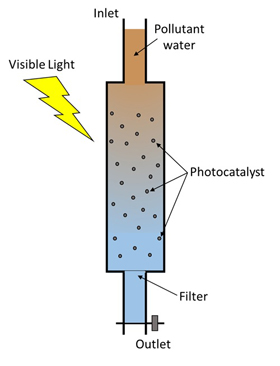A research team has developed a new hybrid photocatalyst that utilizes visible light to break down BPAs. This catalyst could be used for safe disposal of BPAs and other similar materials, and for treating water supplies.
 The photocatalytic nanomaterial can be used to treat water using visible light. CREDIT: D. Bahnemann/LUH Germany
The photocatalytic nanomaterial can be used to treat water using visible light. CREDIT: D. Bahnemann/LUH Germany
In the 1950s, scientists discovered that polycarbonate plastic could be made using BPA. This material is hard, transparent and durable, and has been used in a wide range of applications, including medical devices and water bottles. However, recently, it has lost its popularity due to mounting evidence of its harmful effects to humans and the environment. It is classed as an endocrine disrupting compound that could cause birth defects, cancer and hormonal imbalance.
BPA has been used in food and beverage storage containers, but are phasing out its usage. BPA cannot be easily and safely disposed of because it does not break down easily. Furthermore, it can become an environmental toxin if it leeches into bodies of water.
This new hybrid photocatalyst utilizes photocatalytic oxidation to break down BPA. In this process, an oxidizing chemical reaction is activated using light. When light is used to strike a titanium dioxide (TiO2) nanoparticle photocatalyst, the energy involved can kick an electron to an excited state, leading to an imbalance in charge distribution.
The added electron also creates an excess negative charge at the higher-energy electron band. Furthermore, as an electron has left the lower-energy electron band, excess positive charge exists at this location. This is known as a “hole”. This leaves TiO2 in an unbalanced, excited state, with the ability to catalyze reduction and oxidation reactions of surrounding materials. The hole has the tendency to induce another substance to accept an electron and oxidize, while the excited electron would try to reduce something adjacent to it.
Pure TiO2 possesses a huge bandgap and demonstrates photocatalytic properties only under ultraviolet light. When a material has a large bandgap, a huge amount of energy is required for electrons to get excited to other levels. Additionally, in pure TiO2, the excited electron demonstrates a tendency to combine again with the hole, by rapidly falling back down. This offers the catalyst very little time to induce a reaction when it is in its excited state.
The team modified the TiO2 nanoparticles to improve its photocatalytic properties. Silver was added to the nanoparticle surface to enhance the separation of charges. When light is made to strike the TiO2 nanoparticles, an electron gets excited. This electron would be pulled away by the silver, preventing it from falling back into the hole again. This would enable the hole to better support the oxidation reaction..
The specific wavelength at which the exciting of the photocatalyst occurs is shifted due to the addition of silver. This happens when localized surface plasmon resonance effects are induced. In this phenomenon, energetic electrons on a material’s surface vibrate with a particular frequency, and this improves light absorption over a narrow wavelength range. In this experiment, the light’s wavelength required for photocatalyst activation was shifted towards the visible light spectrum by the silver.
"The inclusion of a noble metal [like silver] in the ultraviolet-responsive TiO2 has significantly extended the spectrum towards the visible light through localized surface plasmon resonance effects," said Pichiah Saravanan, a researcher from University of Malaya who lead the project.
The team then wrapped the Ag/TiO2 nanoparticles in reduced graphene oxide (RGO) sheets. These sheets are made up of thin layers of carbon atoms that are arranged in a honeycomb pattern. RGO assists the hole to accept excited TiO2 electrons so that it would be able to persist. The bandgap of the nanoparticles is also reduced, as is the energy required for photocatalyst activation.
Then, under an artificial visible light source, the BPA solution was mixed with the hybrid nanoparticles. Oxidation of the BPA occurred, and it more effectively broke down. Additionally, the RGO-Ag-TiO2 nanoparticles were more effective than when Ag or RGO was added to TiO2. This suggested that the catalytic activity increased under visible light due to the modifications.
The researchers believe that the findings of this study could aid in breaking down contaminants, including BPA in water supplies. "We strongly feel the developed nano-photocatalyst could be one of the nanomaterials that can sustainably address said problem," said Saravanan.
The findings of this study have been published in the APL Materials journal from AIP Publishing.